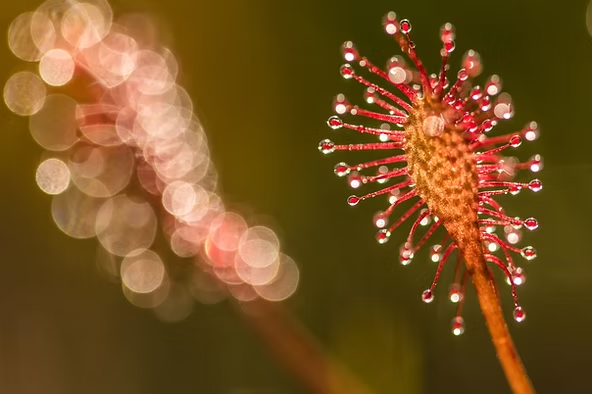Not your average plant: The bug-eating spoonleaf sundew
- Willy's Wilderness
- Jul 13
- 3 min read
Updated: Jul 24
Most people learn by second grade that plants can make their own food. Leaves use photosynthesis to turn sunlight and carbon dioxide into sugar, and roots absorb nutrients and water from the soil. Boom, fact.

But nature is spectacular at breaking the rules we humans try to place on it. A particularly cool rule-breaker grows right here in Will County, a carnivorous plant called spoonleaf sundew.
Just looking at this plant, you might never guess that it is any different. These plants are small and delicate and never grow more than 8 inches tall (about the length of an average banana). Some only reach 2 inches when fully grown.
Words to know
Dormant: Temporarily inactive.
Exotic: Originating in or characteristic of a distant foreign country.
Tentacle: A slender, flexible limb or appendage in an animal used for grasping or moving about or containing sense organs.
Spoonleaf sundew emerges in the spring, with the leaves spreading out in a rosette, or circular rose-like shape. The leaves are green with red tentacles. And just like most plants, this practices photosynthesis to get most of its energy.
However, the roots are not able to find the additional nutrients the plant requires, so this little plant has adapted to eating insects out of necessity. Its preferred home is bogs or fens. These habitats are always wet and have acidic soil that is lacking the nitrogen most plants need. Many plant species, like sedges, have adapted to this poor soil and come to prefer it. But not the sundew. It receives the nutrients it needs by eating insects.
The scientific name of this plant is Drosera intermedia. Drosera comes from the Greek word for dewy, so it is named after the little drops of goo on the tips of each little leaf hair. This plant has three common names, all named after the dewiness as well as the shape of the leaves: oblong-leaved sundew, spoonleaf sundew and spatulate leaf sundew. Do you have any nicknames?

The little dew drops smell like sweet, delicious nectar, but in reality they are a sticky deathtrap! A bug simply looking for a sugary treat gets stuck in the incredibly sticky dew. Slowly, the leaf closes over the bug, and it is eventually digested by the plant. They will eat any small insect that visits, but larger bugs may have a fighting chance to break free from the stickiness.
Watch this time-lapse video of a leaf trapping a little bug.
This plant is so beautiful, it is easy to ignore the bug death it leads to. Between June and August, white five-petaled flowers bloom. Each plant may have three to five tiny flowers — each between the size of the short end and long end of a Tic Tac. In winter, when the plant is dormant, it forms a small, round resting bud called a hibernacula.
There are over 150 different species of sundew plants worldwide. Other carnivorous plant families are pitcher plants, bladderworts, butterworts and the very famous Venus flytrap, which can be found in North Carolina. Spoonleaf sundew is common in the entire eastern half of the United States, including in Will County. You may have always thought of these carnivorous plants as exotic species growing in distant lands. Isn’t it cool knowing they exist right here too?


